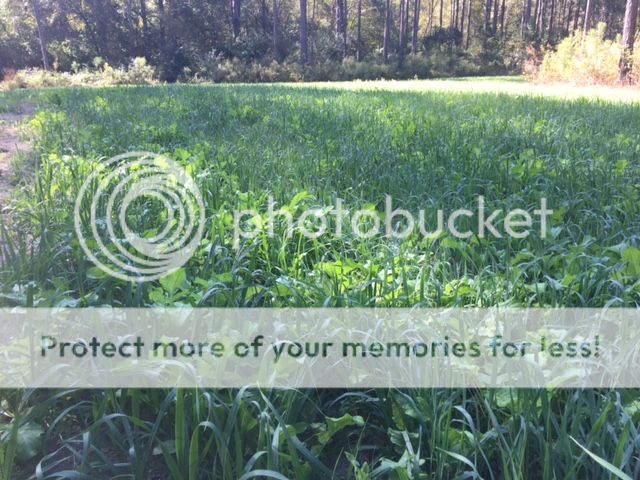You are using an out of date browser. It may not display this or other websites correctly.
You should upgrade or use an alternative browser.
You should upgrade or use an alternative browser.
Want to see a nice plot?
- Thread starter THE LLC
- Start date
I am right there with you all at our place in Elbert county. My father in law and I put down a few hundred pounds of wheat, abruzzi rye, crimson clover and durana in anticipation of this weeks rain. But to be honest I am thinking more about giving the turkeys a green spot come season.
Well sometimes its better to be lucky than good. After seeing all the beautiful pictures LLC has posted over the years I just cannot help myself. Thanks to a combination of planting the day of our last rain over two months ago, some shade and some fields with good moisture retention I really lucked out this year at my place in SE Bama.

 [/URL][/IMG]
[/URL][/IMG]

 [/URL][/IMG]
[/URL][/IMG]

I do have some fields that are not very good, not bare dirt though. I did overseed everything with Rye about 2 1/2 weeks ago. Also planted about a half mile of new firelanes with Rye and planted a clover/chicory field which are all just sitting there waiting for this rain I pray is gonna hit us tommorrow.





I do have some fields that are not very good, not bare dirt though. I did overseed everything with Rye about 2 1/2 weeks ago. Also planted about a half mile of new firelanes with Rye and planted a clover/chicory field which are all just sitting there waiting for this rain I pray is gonna hit us tommorrow.
possum
Active Member
Mine look same over in Wilkes Co. but looks like def getting some rain over next three days. I threw out some deeply discounted tractor supply food plot blends this last weekend. Hopefully when I get back around Christmas there will be some green to hunt for the last hunt of season.
My plots did not come out great either but they did do ok. I believe what helped me was I actually did get my seed on the ground the day prior to good rainfall and I also did a throw and now for the first time. I believe this let my plots keep moisture for a longer period thab they would have thus allowing the plots to grow. If I get a chance on Sunday I will take a pic. Maybe I can get the better half to take one for me too.
THE LLC
Well-Known Member
I see one consistent throughout this thread, conventional tillage. I wonder if some no till plots have any different outcome? I do feel your guys pain and pray you get your needed rains!
No. Friend did and his look the same. Drilled after the ground started drying out so no moisture. Since the drought started in August he couldn't drill any earlier. I can't afford a drill so it's conventional for me.
lakngolf
Well-Known Member
I see one consistent throughout this thread, conventional tillage. I wonder if some no till plots have any different outcome? I do feel your guys pain and pray you get your needed rains!
For the first time in my regular plots I attempted a throw and mow in sections of the field. In one field I devoted the best strip down the middle to TnM, in another I tried this method along the sides, mainly to avoid any plowing around some pear trees.
As I have documented in my property thread, I tilled and then ran over the plots with a chisel plow. The chisel created a furrow that the seed and fertilizer found as I covered with a drag harrow. What little rain we had in two months also settled in those furrows and I was amazed at the wheat, oats and rye. Nothing in the test sections.
My hope now is that this bit of rain we are now getting will again bring back some green in those furrows, but I have no idea what will happen in the test plots, as the turkeys and crows have covered that area.
I might add that the whole area is sandy loam, so there was not much moisture for the TnM areas to preserve.
I guess you would call my method conventional tillage, but to me the chisel altered the method to be as much like a seed drill as I could get with equipment I had. I fully believe the best method is to Mow, and then drill with a seeder. Most of us cannot avoid that method.
lakngolf
Well-Known Member
Well not hardly a drop of rain for me. Somehow the 100% forecast turned into a 0% forecast in about 12 hours. Wish I could screw up at my job that bad and still be employed.
That's payback for posting those beautiful food plot pictures!!
THE LLC
Well-Known Member
Well not hardly a drop of rain for me. Somehow the 100% forecast turned into a 0% forecast in about 12 hours. Wish I could screw up at my job that bad and still be employed.
Exactly. NEVER trust a weatherman that doesn't farm or hunt. Trust me.
Smallplot
Active Member
No. Friend did and his look the same. Drilled after the ground started drying out so no moisture. Since the drought started in August he couldn't drill any earlier. I can't afford a drill so it's conventional for me.
Lots of food plotters never consider water management especially with fall plots because lets face it, that is a time when we generally have moisture. I also understand may don't have the equipment to move towards a no-till system, or do they? Further, more how many did not have all their eggs in the same basket so the season is not a total loss and how many have learned a valuable lesson from this year?
While going without moisture for extended periods of time can be the downfall of any plot, has everything been done to retain as much water as possible? Does the soil contain enough of a root system to hold moisture for later use? Were weeds controlled during that early period where the weeds did not use water remaining in storage to make it available to new plants? Did we have enough of a layer of duff to give the soil a thermal blanket to reduce the soil temp which drives down the amount of escaping water vapor? And lastly, but most importantly, does our soil have enough natural glue to keep the particulate in place while allowing maximum water absorption into the soils surface to receive the full benefit of maximum water storage?
Not knocking the conventional tillage, just trying to alter conventional thinking. I actually love your post because it shows there is more to this management tool than using a no-till drill to get results. Thanks for sharing.
Soil water dynamic is important....good field management is important.....but when you are dealing with lack of fall hurricane driven storm systems they become moot points to the whole. Paucity of hurricanes in the late summer southern gulf is a major change in regional climate pattern....what 5 or so years now? The better question to answer is how long will this new climate pattern persist?.....and how must we adjust management to cope?
Do droughts not imply 'trimming off the fat in management' by stopping plotting and relying on enhanced native habitat to meet the needs of a herd in proper density?
Has plotting attempted to falsely inflate land carrying capacity rather than supplement times of normal native forage deficit?
Have past goals and management steps attracted more deer than a poor year can support? Or is the herd size in balance with slightly less than average carrying capacity?
How well has your native habitat carried the herd through drought while plots failed? Are plots really working to your benefit?
Is a high fawn recruitment rate beneficial to your area? Predation an asset or liability?
Has resilience to environmental stress been bred out the plants we are buying seed to grow?
Hard drought should make one think through those answers by looking hard at the animals and the pocketbook....that is....if the goal is land stewardship and herd health/productivity...in an economical and least effort manner.
The problem with most state wildlife regulations is that surplus animals cannot be removed in a timely manner to cope with short to medium term shortages in habitat provision while many state deer populations teeter annually on the high side.
Do droughts not imply 'trimming off the fat in management' by stopping plotting and relying on enhanced native habitat to meet the needs of a herd in proper density?
Has plotting attempted to falsely inflate land carrying capacity rather than supplement times of normal native forage deficit?
Have past goals and management steps attracted more deer than a poor year can support? Or is the herd size in balance with slightly less than average carrying capacity?
How well has your native habitat carried the herd through drought while plots failed? Are plots really working to your benefit?
Is a high fawn recruitment rate beneficial to your area? Predation an asset or liability?
Has resilience to environmental stress been bred out the plants we are buying seed to grow?
Hard drought should make one think through those answers by looking hard at the animals and the pocketbook....that is....if the goal is land stewardship and herd health/productivity...in an economical and least effort manner.
The problem with most state wildlife regulations is that surplus animals cannot be removed in a timely manner to cope with short to medium term shortages in habitat provision while many state deer populations teeter annually on the high side.
possum
Active Member
Well did get a good rain finally last week and calling for more over next three days.
So now the problem faced is temps. Supposed to get down to 23 degrees next week so I'm guessing that will kill off any new growth coming up.
Food plotting just stinks this year in the southeast.
Lesson learned going to do more perennial plots from now on and rotate them every three years or so. So if this happens again at least I'll have something of a green plot to hunt if there is ever another fall this dry
So now the problem faced is temps. Supposed to get down to 23 degrees next week so I'm guessing that will kill off any new growth coming up.
Food plotting just stinks this year in the southeast.
Lesson learned going to do more perennial plots from now on and rotate them every three years or so. So if this happens again at least I'll have something of a green plot to hunt if there is ever another fall this dry
